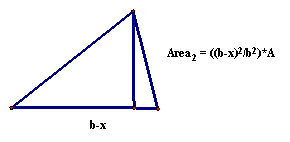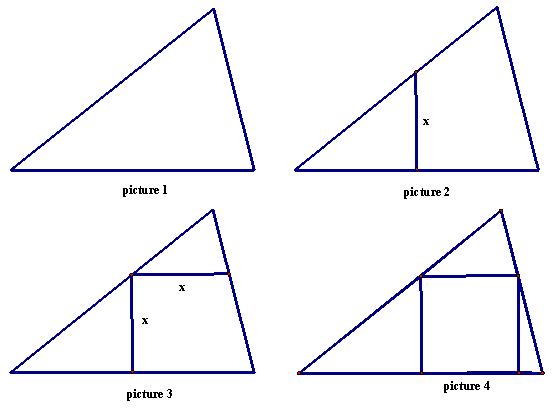An Old Problem:
A Square in a Triangle
|
The origins of algebra are closely connected to geometry. Problems that connect questions about length, area, and volume lead to interesting equations. Early algebraic equalities were viewed as relationships among geometric quantities. Below we present an early algebraic problem that appeared in the writing of Heron (1st century A. D.) and the writing of al Khwarizmi (9th century A. D.) (The Exact Sciences in Antiquity, O. Neugebauer, Dover Publications, NY, 1969.) Problem A square is inscribed in a triangle as shown in the picture below. A Modern Solution The area of the whole triangle is b*h/2. The area of the small triangle on the top is x*(h-x)/2 The area of the square is x2. The area of the triangle that is obtained by sliding together the two smaller triangles standing on the base is (b-x)*x/2.
b*h/2 = x*(h-x)/2 + x2 + (b-x)*x/2
Sob*h = x*(h-x) + 2*x2 + (b-x)*x = x*h - x2 + 2*x2 + b*x - x2 = x*h + b*x = x*(h + b)
x = b*h/(b + h).
Click on the Flash animation below to view step-by-step how a square in a triangle is made: A Modern Solution In some triangles (e.g., those with three angles that measure 90 degrees or less), three different squares may be inscribed, one for each of the three sides. Do the three squares have the same area? The answer is, not always; the area of the inscribed square is a function of the length of the side on which it sits. Below we derive the formula. Formula for a square inscribed in a triangle, sitting on one side of the triangle. Let A be the area of a triangle and let b be the length of the side on which a square stands, and let x be the side of the square.    
(x2/b2)*A + ((b-x)2/b2)*A + x2 = A
Dividing by A and multiplying by b2 gives
x2 + (b-x)2 + x2*b2/A = b2
Therefore (because x>0), we can divide the equation above by x, and we have:x2 + b2 - 2*b*x + x2 + x2*b2/A = b2 (2 + b2/A)*x2 - 2*b*x = 0
x = b/(1 + b2/A/2) = b/(1 + b2/(2*A)) = 1/(1/b+b/(2*A))
So we see that x depends on the side b on which the square is built.See also http://www.hawaii.edu/suremath/jsquareInTriangle.html A Third Problem Given a triangle such as the one in picture 1 below, inscribe in it a square that sits on one of the triangle's sides. One way to do this is described below the pictures.  Using an index card, mark length x on one of its sides. Run the unmarked edge of the index card along the base until the mark x cuts the edge of the triangle. Draw length x perpendicular to the base b, as in picture 2. Turn the card 90 degrees, and along the top of the card draw a segment of length x parallel to the base (picture 3). Again using the index card, finish the square by drawing another segment of length x perpendicular to the base (picture 4). Lesson Index |